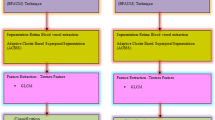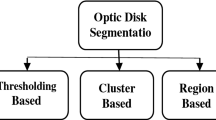Abstract
Glaucoma is a disease characterized by damaging the optic nerve head, this can result in severe vision loss. An early detection and a good treatment provided by the ophthalmologist are the keys to preventing optic nerve damage and vision loss from glaucoma. Its screening is based on the manual optic cup and disc segmentation to measure the vertical cup to disc ratio (CDR). However, obtaining the regions of interest by the expert ophthalmologist can be difficult and is often a tedious task. In most cases, the unlabeled images are more numerous than the labeled ones.We propose an automatic glaucoma screening approach named Super Pixels for Semi-Supervised Segmentation “SP3S”, which is a semi-supervised superpixel-by-superpixel classification method, consisting of three main steps. The first step has to prepare the labeled and unlabeled data, applying the superpixel method and bringing in an expert for the labeling of superpixels. In the second step, We incorporate prior knowledge of the optic cup and disc by including color and spatial information. In the final step, semi-supervised learning by the Co-forest classifier is trained only with a few number of labeled superpixels and a large number of unlabeled superpixels to generate a robust classifier. For the estimation of the optic cup and disc regions, the active geometric shape model is used to smooth the disc and cup boundary for the calculation of the CDR. The obtained results for glaucoma detection, via an automatic cup and disc segmentation, established a potential solution for glaucoma screening. The SP3S performance shows quantitatively and qualitatively similar correspondence with the expert segmentation, providing an interesting tool for semi-automatic recognition of the optic cup and disc in order to achieve a medical progress of glaucoma disease.









Similar content being viewed by others
Explore related subjects
Discover the latest articles, news and stories from top researchers in related subjects.Notes
A bootstrap sample L is, for example, obtained by randomly drawing n observations with replacement from the training sample \(L_n\) each observation with a probability 1/n to be drawn.
References
Abramoff, M. D., Alward, W. L. M., Greenlee, E. C., Shuba, L., Kim, C. Y., Fingert, J. H., et al. (2007). Automated segmentation of the optic disc from stereo color photographs using physiologically plausible features. Investigative Ophthalmology and Visual Science, 48(4), 1665. doi:10.1167/iovs.06-1081.
Achanta, R., Shaji, A., Smith, K., Lucchi, A., Fua, P., & Susstrunk, S. (2012). Slic superpixels compared to state-of-the-art superpixel methods. IEEE Transactions on Pattern Analysis and Machine Intelligence, 34(11), 2274–2282. doi:10.1109/TPAMI.2012.120.
Benazzouz, M., Baghli, I., & Chikh, M. A. (2013). Microscopic image segmentation based on pixel classification and dimensionality reduction. The International Journal of Imaging Systems and Technology, 23(1), 22–28.
Blum, A., & Mitchell, T. (1998). Combining labeled and unlabeled data with co-training. Proceedings of the Eleventh Annual Conference on Computational Learning Theory, New York, NY, USA, COLT’, 98, 92–100.
Breiman, L. (1996). Bagging predictors. Machine Learning, 24(2), 123–140. doi:10.1023/A:1018054314350.
Breiman, L. (2001). Random forests. Machine Learning, 45, 5–32.
Chapelle, O., Schölkopf, B., & Zien, A. (2006). Semi-supervised Learning. Cambridge, MA: MIT Press.
Cheng, J., Liu, J., Xu, Y., Yin, F., Wong, D. W. K., Tan, N. M., Cheng, C. Y., Tham, Y. C., & Wong, T. Y. (2013a). Superpixel classification based optic disc segmentation. In Proceedings of the 11th Asian conference on computer vision-volume Part II, ACCV’12 (pp. 293–304). Springer, Berlin. doi:10.1007/978-3-642-37444-9_23.
Cheng, J., Liu, J., Xu, Y., Yin, F., Wong, D. W. K., Tan, N. M., et al. (2013). Superpixel classification based optic disc and optic cup segmentation for glaucoma screening. IEEE Transactions on Medical Imaging, 32(6), 1019–1032. doi:10.1109/TMI.2013.2247770.
Cootes, T. F., Taylor, C. J., Cooper, D. H., & Graham, J. (1995). Active shape models-their training and application. Computer Vision and Image Understanding, 61(1), 38–59. doi:10.1006/cviu.1995.1004.
Cornuéjols, A., & Miclet, L. (2010). Apprentissage artificiel : Concepts et algorithmes. Eyrolles. http://hal.inria.fr/inria-00538947.
Crowston, J. G., Hopley, C. R., Healey, P. R., Lee, A., & Mitchell, P. (2004). The effect of optic disc diameter on vertical cup to disc ratio percentiles in a population based cohort: the blue mountains eye study. The British Journal of Ophthalmology, 88(6), 766–770. doi:10.1136/bjo.2003.028548.
Danesh-Meyer, H., Gaskin, B., Jayusundera, T., Donaldson, M., & Gamble, G. (2006). Comparison of disc damage likelihood scale, cup to disc ratio, and heidelberg retina tomograph in the diagnosis of glaucoma. British Journal of Ophthalmology, 90(4), 437–441.
Deng, C., & Guo, M. (2011). A new co-training-style random forest for computer aided diagnosis. Journal of Intelligent Information Systems, 36(3), 253–281.
Dietterich, T. G., & Bakiri, G. (1991). Error-correcting output codes: A general method for improving multiclass inductive learning programs. In In Proceedings of AAAI-91 (pp. 572–577). AAAI Press.
Foley, J. D., van Dam, A., Feiner, S. K., & Hughes, J. F. (1990). Computer Graphics: Principles and Practice (2nd ed.). Boston, MA: Addison-Wesley Longman Publishing Co., Inc.
Freund, Y., & Schapire, R. E. (1996). Experiments with a new boosting algorithm. In L. Saitta (Ed.), Proceedings of the thirteenth international conference on machine learning (ICML 1996) (pp. 148–156). Burlington: Morgan Kaufmann.
Fumero, F., Alayon, S., Sanchez, J. L., Sigut, J. F., & Gonzalez-Hernendez, M. (2011). Rim-one: An open retinal image database for optic nerve evaluation. In CBMS, IEEE Computer Society (pp. 1–6). http://dblp.uni-trier.de/db/conf/cbms/cbms2011.html#FumeroASSG11.
Giannakeas, N., Karvelis, P. S., Exarchos, T. P., Kalatzis, F. G., & Fotiadis, D. I. (2013). Segmentation of microarray images using pixel classification: Comparison with clustering-based methods. Computers in Biology and Medicine, 43(6), 705–716.
Haleem, M. S., Han, L., van Hemert, J., & Li, B. (2013). Automatic extraction of retinal features from colour retinal images for glaucoma diagnosis: A review. Computerized Medical Imaging and Graphics, 37(7), 581–596. doi:10.1016/j.compmedimag.2013.09.005.
Ho, T. K. (1998). The random subspace method for constructing decision forests. IEEE Transactions on Pattern Analysis and Machine Intelligence, 20(8), 832–844. doi:10.1109/34.709601.
Joshi, G. D., Sivaswamy, J., & Krishnadas, S. R. (2011). Optic disk and cup segmentation from monocular color retinal images for glaucoma assessment. IEEE Transactions on Medical Imaging, 30(6), 1192–1205. doi:10.1109/TMI.2011.2106509.
Kande, G. B., Subbaiah, P. V., & Tirumala, S. S. (2010). Unsupervised fuzzy based vessel segmentation in pathological digital fundus images. The Journal of Medical Systems, 34(5), 849–858.
Kass, M., Witkin, A., & Terzopoulos, D. (1987). Snakes: Active contour models. International Journal of Computer Vision, 1(4), 321–331.
Krogh, A., & Vedelsby, J. (1995). Neural network ensembles, cross validation, and active learning. Advances in Neural Information Processing Systems, 7, 231–238.
Lalonde, M., Beaulieu, M., & Gagnon, L. (2001). Fast and robust optic disc detection using pyramidal decomposition and hausdorff-based template matching. IEEE Transactions on Medical Imaging, 20(11), 1193–1200.
Li, C., Kao, C. Y., Gore, J. C., & Ding, Z. (2007). Implicit active contours driven by local binary fitting energy. In CVPR, IEEE Computer Society. http://dblp.uni-trier.de/db/conf/cvpr/cvpr2007.html#LiKGD07.
Li, H., & Chutatape, O. (2004). Automated feature extraction in color retinal images by a model based approach. IEEE Transactions on Biomedical Engineering, 51(2), 246–254. doi:10.1109/TBME.2003.820400.
Li, M., & Zhou, Z. H. (2007). Improve computer-aided diagnosis with machine learning techniques using undiagnosed samples. IEEE Transactions on Systems, Man, and Cybernetics, Part A, 37(6), 1088–1098. doi:10.1109/TSMCA.2007.904745.
Maeireizo, B., Litman, D., & Hwa, R. (2004). Co-training for predicting emotions with spoken dialogue data. In Proceedings of the 42th annual meeting of the association for computational linguistics (ACL-2004).
Merickel, M. B., Abramoff, M. D., Sonka, M., & Wu, X. (2007). Segmentation of the optic nerve head combining pixel classification and graph search. Proceedings of the SPIE, 6512, 651, 215–651, 215–651, 215–10. doi:10.1117/12.710588.
Mittapalli, P. S., & Kande, G. B. (2016). Segmentation of optic disk and optic cup from digital fundus images for the assessment of glaucoma. Biomedical Signal Processing and Control, 24, 34–46. doi:10.1016/j.bspc.2015.09.003.
Mohamed, N., Zulkifley, M., & Hussain, A. (2015). On analyzing various density functions of local binary patterns for optic disc segmentation. In 2015 IEEE symposium on computer applications industrial electronics (ISCAIE) (pp. 37–41).
Muramatsu, C., Nakagawa, T., Sawada, A., Hatanaka, Y., Hara, T., Yamamoto, T., et al. (2011). Automated segmentation of optic disc region on retinal fundus photographs: Comparison of contour modeling and pixel classification methods. Computer Methods and Programs in Biomedicine, 101(1), 23–32.
Neubert, P., & Protzel, P. (2012). Superpixel benchmark and comparison. In Proceedings of Forum Bildverarbeitung, Regensburg, Germany.
Nigam, K., & Ghani, R. (2000). Analyzing the effectiveness and applicability of co-training. In Proceedings of the ninth international conference on information and knowledge management (pp. 86–93). ACM, New York, NY, USA, CIKM ’00. doi:10.1145/354756.354805.
Shaarawy, T., Sherwood, M., & Crowston, J. (2009). Glaucoma: Medical diagnosis and therapy. ClinicalKey 2012, Saunders/Elsevier. https://books.google.fr/books?id=-1wtvjCY6dcC.
Walter, T., & Klein, J. C. (2001). Segmentation of color fundus images of the human retina: Detection of the optic disc and the vascular tree using morphological techniques. In Proceedings of the second international symposium on medical data analysis (pp. 282–287). Springer, London, UK, UK, ISMDA ’01. http://dl.acm.org/citation.cfm?id=646351.691036.
Wang, Q., & Boyer, K. L. (2012). The active geometric shape model: A new robust deformable shape model and its applications. Computer Vision and Image Understanding, 116(12), 1178–1194. doi:10.1016/j.cviu.2012.08.004.
Wong, D., Liu, J., Lim, J., Jia, X., Yin, F., Li, H., & Wong, T. (2008). Level-set based automatic cup-to-disc ratio determination using retinal fundus images in argali. In Engineering in medicine and biology society, 2008. EMBS 2008. 30th Annual international conference of the IEEE (pp 2266–2269). doi:10.1109/IEMBS.2008.4649648.
Xu, C., & Prince, J. L. (1998). Snakes, shapes, and gradient vector flow. IEEE Transactions on Image Processing, 7(3), 359–369.
Xu, Y., Xu, D., Lin, S., 0001, J. L., Cheng, J., lui Cheung, C. Y., Aung, T., & Wong, T. Y. (2011). Sliding window and regression based cup detection in digital fundus images for glaucoma diagnosis. In G. Fichtinger, A. L. Martel, T. M. Peters (eds.) MICCAI (3), Springer, Lecture Notes in Computer Science (vol. 6893, pp. 1–8). http://dblp.uni-trier.de/db/conf/miccai/miccai2011-3.html#XuXLLCCAW11.
Xu, Y., Duan, L., Lin, S., Chen, X., Wong, D. W. K., & Wong, T. Y., et al. (2014). Optic cup segmentation for glaucoma detection using low-rank superpixel representation. In Proceedings of the international conference on medical image computing and computer assisted intervention (pp. 788–795). Boston, Massachusetts.
Yarowsky, D. (1995). Unsupervised word sense disambiguation rivaling supervised methods. In Proceedings of the 33rd annual meeting on association for computational linguistics, Association for computational linguistics (pp. 189–196). Stroudsburg, PA, USA, ACL ’95. doi:10.3115/981658.981684.
Author information
Authors and Affiliations
Corresponding author
Rights and permissions
About this article
Cite this article
Bechar, M.E., Settouti, N., Barra, V. et al. Semi-supervised superpixel classification for medical images segmentation: application to detection of glaucoma disease. Multidim Syst Sign Process 29, 979–998 (2018). https://doi.org/10.1007/s11045-017-0483-y
Received:
Revised:
Accepted:
Published:
Issue Date:
DOI: https://doi.org/10.1007/s11045-017-0483-y




